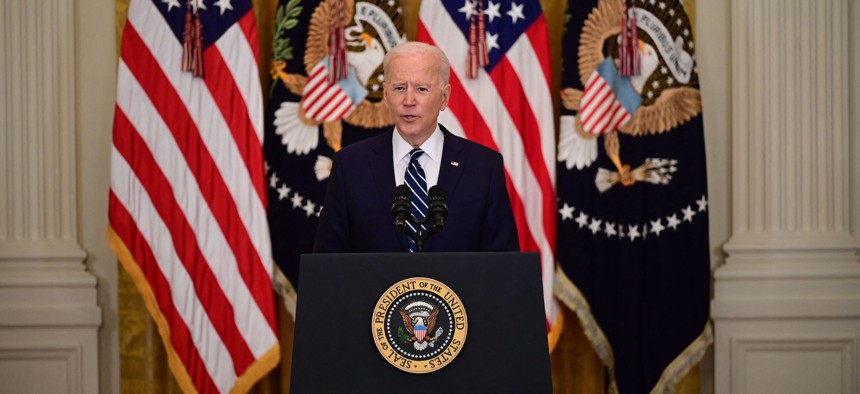
US President Joe Biden speaks during his first press briefing in the East Room of the White House in Washington, DC, on March 25, 2021. Photo by JIM WATSON/AFP via Getty Images
Eyeing China, Biden’s First Pentagon Budget Would Cut Troops, Buy Future Weapons
DepSecDef Hicks called the president’s $715 billion spending request “a foundation for fielding a full range of needed capabilities.” Republicans called it “a cut.”
The Biden administration is proposing cuts to the military’s ranks and arsenals in an effort to invest in a new generation of high-tech weapons to counter China.
In a $715 billion spending plan sent to Congress Friday, the Biden administration proposes sidelining ships and hundreds of aircraft to pay for fast-flying hypersonic missiles and newer generation warships.
“To defend the nation, the department in this budget takes a clear-eyed approach to Beijing and provides the investments to prioritize China as our pacing challenge,” Deputy Defense Secretary Kathleen Hicks said Friday. “The PRC has become increasingly competitive in the Indo-Pacific region and around the world. It has the economic, military and technological capability to challenge the international system and American interests within it.”
The $715 billion request is $11 billion more than the $704 billion Congress enacted for the current fiscal year, but if inflation stays around 4 percent, it will represent about a 3 percent real decrease.
Officials touted a $112 billion request for research and development of new weapons. Pentagon officials said it is the highest R&D request ever and a 5 percent increase over the previous year’s request, but it amounts to a boost of less than 1 percent when adjusted for inflation.
“This will provide the foundation for fielding a full range of needed capabilities such as hypersonic missiles, artificial intelligence, and 5G,” Hicks said.
Cutting old weapons to pay for new ones is not unique to the Biden administration; the Trump administration used the same strategy in its fiscal 2021 budget proposal last year.
Conservatives have pushed for a 3 percent to 5 percent annual increase, above inflation, to the defense budget.
“President Biden’s defense budget request is wholly inadequate—it’s nowhere near enough to give our service members the resources, equipment and training they need,” Sen. James Inhofe, R-Okla, and Rep. Mike Rogers, R-Ala., ranking members of the Senate and House Armed Services committees, said in a joint statement. “It’s disingenuous to call this request an increase because it doesn’t even keep up with inflation—it’s a cut.”
Biden’s request—the latest any presidential administration in the past 100 years has submitted its annual spending request to Congress—is already getting pushback from lawmakers on both sides of the aisle for its proposed cuts to aircraft and ships.
“I agree there are some systems that must be retired to make way for newer, more effective systems,” Rep. Ken Calvert, R-Calif., the ranking member of the House Appropriations defense subcommittee said at Thursday’s hearing. “However, DOD cannot make these decisions in a vacuum.”
At the same hearing, Rep. Cheri Bustos, D-Ill., objected to plans to cut C-130s from the Air National Guard.
“The flexibility readiness of the National Guard will be negatively impacted by any reduction in the C-130s,” she said.
The Pentagon requested 85 F-35 stealth fighters for the Air Force, Navy, and Marine Corps, 11 fewer than it asked for in last year’s spending request. It also plans to end production of the F/A-18 Super Hornet, a proposal that is likely to face resistance from Boeing and its advocates in Congress.
The budget requests more than $27 billion to modernize the U.S. nuclear arsenal, Vice Adm. Ronald Boxall, director of force structure, resources, and assessment for the Joint Staff, said during a Friday briefing at the Pentagon.
The proposal would spend $2.6 billion on the Ground-Based Strategic Deterrent, the much-debated Minuteman III intercontinental ballistic missile replacement, and the $609 million Long-Range Standoff Weapon, a new nuclear-tipped cruise missile. Progressive democrats have called for canceling these projects.
“Continued spending on unnecessary weapons systems like a new Intercontinental Ballistic Missile (ICBM) and a nuclear-armed sea-launched cruise missile is a particularly egregious misuse of taxpayer funds, diverting billions of dollars from other urgent national priorities,” said William Hartung, director of the Arms and Security Program at the Center for International Policy.
The Biden administration is proposing $36.6 billion for shipbuilding, a 13 percent increase from what the Trump administration requested last year. It also wants to spend $16.7 billion on space-related projects, that’s an increase from $15.5 billion. The Pentagon also wants increase spending on its efforts to connect weapons and troops on the battlefield.
The plan calls for cutting just 4,600 troops from all branches of the active-duty military, reducing the end strength of each service except the Space Force, which is expected to grow by 2,000 guardians.
The budget proposal also calls for spending $52.4 billion on military aircraft, down from the $56.9 billion the Trump administration requested for fiscal 2021.
Less money was also requested for ground weapons—$12.3 billion compared to $13 billion last year. There’s also a drop in the missile defense spending request, which comes in at $10.9 billion, down from $11.6 billion, and missiles and bombs, which drops to $20.3 billion down from $21.3 billion.





